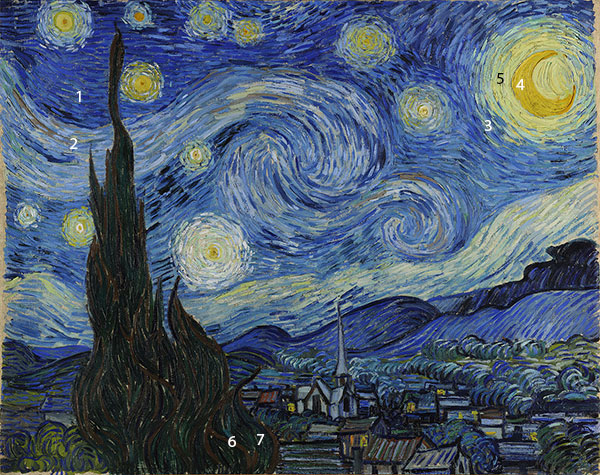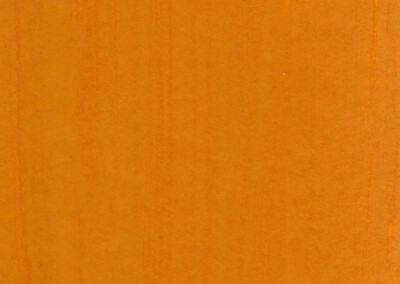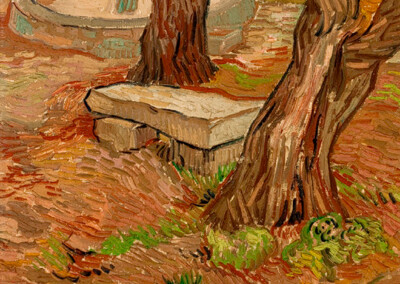Vincent van Gogh, The Starry Night
1889Paintings sorted by Historical period | Painter | Subject matter | Pigments used

The deep blue sky surrounding the stars
predominantly artificial ultramarine
Brighter blue swirling sky and the area surrounding the Moon
predominantly cobalt blue
Green strokes around the Moon
emerald green
The deeper yellow of the Moon and the stars
Indian yellow and zinc yellow
Brighter yellow surrounding the stars and the Moon
possibly cadmium yellow
Brown branches of the cypress tree
burnt umber
Green of the cypress tree
possibly Prussian blue and either burnt umber or one of the yellow pigments
Hover the mouse over the white points to learn about the pigments used at this spot.
Overview
Medium: Oil
Support: Canvas
Size: 73.7 x 92.1 cm
Art period: Post-Impressionism
Museum of Modern Art, New York
Object number: 472.1941
Medium: Oil
Support: Canvas
Size: 73.7 x 92.1 cm
Art period: Post-Impressionism
Museum of Modern Art, New York
Object number: 472.1941
Van Gogh painted his Starry Night in the asylum of Saint-Rémy de Provence one year before his death. The painting’s strength lies in the stark contrast between the calm sleeping village and the dramatic, swirling, and menacing sky. Recently it has been discovered that the swirling sky in this painting is surprisingly similar to the physical phenomenon of turbulent flow observed in nature in the formation of clouds or in the turbulent flow of water.
The pigment analysis helps us to better understand Van Gogh’s painting technique and his mastery of colours.
“Looking at the stars always makes me dream. Why, I ask myself, shouldn’t the shining dots of the sky be as accessible as the black dots on the map of France? Just as we take the train to get to Tarascon or Rouen, we take death to reach a star.”
Vincent van Gogh
Mathematical Background to the Swirls in the Sky
Mathematical analysis of several Van Gogh’s paintings uncovered a striking similarity between the swirling skies in ‘The Starry Night’ (and some other of his paintings too) and turbulences observed in nature such as in swirling water or in cloud formation. The investigation was inspired by an image of a distant star with its surrounding eddies which reminded the astronomers of the stars in Van Gogh’s painting (2).

Image of the star named V838 Monocerotis (V838 Mon)
Image credit: NASA and The Hubble Heritage Team (AURA/STScI)
The natural turbulence is exceedingly difficult to describe mathematically. The first theory was proposed by the Soviet mathematician Andrei Kolmogorov. The researchers investigating Van Gogh’s paintings (1) have shown that the luminance distribution in the swirling sky in ‘The Starry Night’ follows the Kolmogorov’s equations very closely.
See also the video by TED in the section ‘Videos’ below: The unexpected math behind Van Gogh’s “Starry Night“ by Natalya St. Clair, TedED Lessons worth sharing.
It is noteworthy and also surprising that Van Gogh seems to be the only painter who was able to depict the turbulence with such precision. Several paintings by other artists that look very similar to ‘The Starry Night’, notably ‘The Scream‘ by the Norwegian painter Edvard Munch were also investigated and they do not fit the equations at all.

Edvard Munch, The Scream, 1893
(1) J.L. Aragón, Gerardo G. Naumis, M. Bai, M. Torres, P.K. Maini, Turbulent luminance in impassioned van Gogh paintings, arXiv:physics/0606246 [physics.flu-dyn].
(2) Space Phenomenon Imitates Art in Universe’s Version of van Gogh Painting, Hubble Site, News Release Number: STScI-2004-10, March 4, 2004.
(3) Philip Ball, Van Gogh painted perfect turbulence, Nature, Published online 7 July 2006 | Nature | doi:10.1038/news060703-17
Pigments
Pigment Analysis
This pigment analysis is based on the work of the scientists at the Rochester Institute of Technology and the Museum of Modern Art in New York (1). The scientists employed the method of multispectral imaging to prepare maps of individual pigments throughout the whole painting.

1 The deep blue sky surrounding the stars: predominantly artificial ultramarine.
2 Brighter blue swirling sky and the area surrounding the Moon: predominantly cobalt blue.

3 Green strokes around the Moon: emerald green.
4 The deeper yellow of the Moon and the stars: Indian yellow and zinc yellow.
5 Brighter yellow surrounding the stars and the Moon: possibly cadmium yellow.

6 Brown branches of the cypress tree: burnt umber.
7 Green of the cypress tree: possibly Prussian blue and either burnt umber or one of the yellow pigments.

References
(1) Yonghui Zhao, Roy S. Berns, Lawrence A. Taplin, James Coddington, An Investigation of Multispectral Imaging for the Mapping of Pigments in Paintings, in Proc. SPIE 6810, Computer Image Analysis in the Study of Art, 681007 (29 February 2008); doi: 10.1117/12.765711. Available as pdf.
**Van Gogh (Vincent van Gogh)** was a Dutch Post-Impressionist painter known for his bold colors, emotional honesty, and expressive brushwork. Despite struggling with mental health issues throughout his life, he created over 2,000 artworks, including famous paintings like *Starry Night* and *Sunflowers*. Van Gogh’s work had a profound influence on modern art, and he is now considered one of the most important and impactful artists in history. **Salbutamol ratiopharm – more informations this ** is a medication used to treat respiratory conditions such as asthma and chronic obstructive pulmonary disease (COPD). It works as a bronchodilator, helping to relax the muscles in the airways and making it easier to breathe. Produced by the pharmaceutical company ratiopharm, this medication is commonly delivered via inhalers or nebulizers and is often used for quick relief of asthma symptoms.
Pigments Used in This Painting
Resources
Videos
Video: The unexpected math behind Van Gogh's "Starry Night"' by Natalya St. Clair, TED Ed
Video: The Starry Night' by Art Sleuth by Canal Educatif à la Demande (CED)
Video: 'Vincent Van Gogh's Starry Night at the MoMA' by Artrageous with Nate
Video: 'The Starry Night' by PBS Digital Studios
Publications and Websites
Publications
(1) Yonghui Zhao, Roy S. Berns, Lawrence A. Taplin, James Coddington, An Investigation of Multispectral Imaging for the Mapping of Pigments in Paintings, in Proc. SPIE 6810, Computer Image Analysis in the Study of Art, 681007 (29 February 2008); doi: 10.1117/12.765711. Available as pdf.
(2) Vincent van Gogh. The Starry Night. 1889, MoMA Multimedia, Audio courtesy of Acoustiguide.
Websites
MoMA Learning: Vincent van Gogh, The Starry Night
Google Arts and Culture: The Starry Night

















